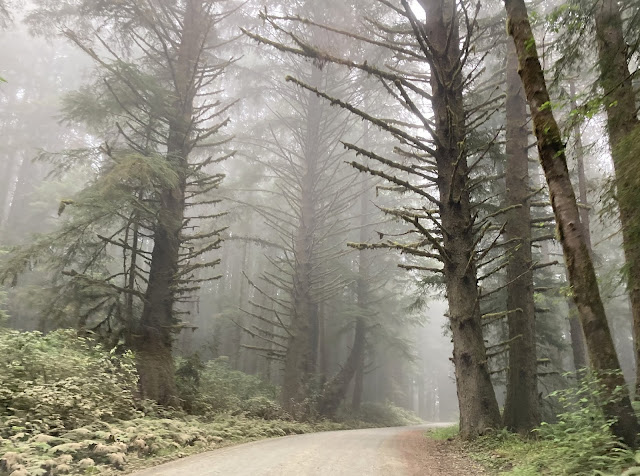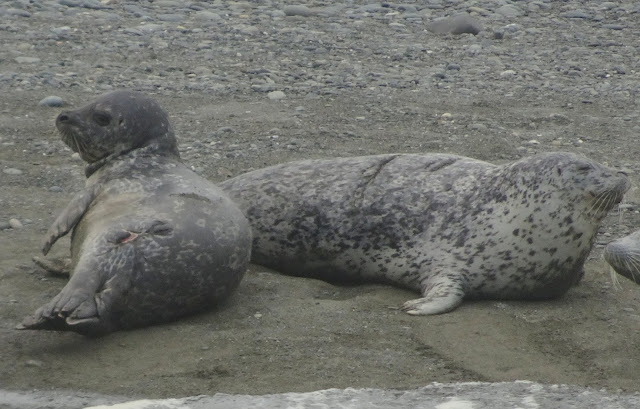Because of our motor home breakdown last week, we're having to pick up speed as we head south along the California coast. It normally would have taken us several days to see all the interesting sights that we saw today. So hang on to your screen, because we're picking up speed on this sight-seeing day! From our overnight camping spot at Elk Valley Casino, we found it was only a few miles down Howland Hill Road to get to our first destination today. The Jedidiah Smith State Park was recommended to us 4 years ago, and we remember it fondly. So it is top on our list of things to do again today. We are glad to say that we are driving through fog today--not smoke!
It looks a little spooky as we continue down the dirt road to our destination. We found out later that this little road was closed a few days after because a tree had fallen over it. When these big trees fall, it can take a while to clear it off the road.
As we drove further, the trees got bigger and the road got narrower. We laughed as we remembered that we could roll down our windows and we could both reach out and touch giant redwoods at the same time. Meeting a vehicle coming the opposite direction makes for an interesting dilemma on Howland Hills Road.
We obviously aren't the first people that have made this drive on this road as everything looks dusty.
The ferns and sorrel are no longer green. They all have a thick covering of road dirt.
The parking lot was getting crowded, but we found a parking spot so we could start the hike into the Stout Grove of Redwoods.
Owned by her lumber baron husband, Mrs. Stout donated this grove of old-growth redwoods to the state park after he died. So this grove was named in honor of the Stouts. We're glad that Mr. Stout never got around to cutting these trees down!
One reason that they can grow so old is that they are resistant to fire. Their bark doesn't contain the resins that cause some trees to burst into flames. So even though these giants have been scarred by forest fires, it doesn't kill them.
It's almost impossible to photograph how tall these trees are, but we certainly tried anyway.
When walking through a redwood forest, we can see that these giants do die, and they will topple to the ground.
It's probably easier to see how tall they are when they are lying horizontal on the ground. Taken from the middle of this fallen log, we can see Mark down at one end . . .
and Denisa far away on the other end. We can tell you that we are farther apart than we can get in our 35-foot motor home.
It's also interesting to see the size of the base when a fallen tree is horizontal. For such tall trees, they really don't have a very big root system.
Our trail through the Stout Grove had a spur that led us to the Smith River, and Mark is standing on the foot bridge over it.
The Smith River is perfectly clear, as we can see the rocks underneath like they were under a pane of glass. Remember this river, as we will see it again later today.
Occasionally a tree is singled out and named, or a platform is built around its base to protect its roots.
When we hiked up to this giant, a passerby offered to take our picture together on that platform. He instructed us to stretch our arms out wide to show how big it was, and we quickly followed his directions as he clicked the picture.
Our next stop was the Hiouchi Visitor Center of the Redwood National Park. We found out that there are three California state parks that were started here in the 1920s to preserve the groves of big trees. In 1968, more trees were protected in the Redwood National Park that surrounds the state parks. Now both the state and national park systems work together to preserve this area of trees. At this national park visitor center, they were posting road closings (highway 299 and 36) and the locations of nearby fires. It also posts that nearby Lasson Volcanic National Park (which we had planned to visit this year) is closed.
We always learn things when we visit national parks. For example, the redwoods that grow so well here on the Northern California coast, are the world's tallest living things. The Giant Sequoias, that only grow on the western slopes of the Sierra Nevada mountains south of here, are the world's largest trees in volume. The Giant Sequoias aren't as tall, but they are bigger around.
Just to show the difference, they planted this sequoia tree here in coastal California in 1981. The picture below makes it look like Mark is wearing it as a hat.
The other thing that enjoys the climate of the Northern California coast is the banana slug. We found one of these bright-yellow-slow-moving slugs at our next stop.
We are now at the Simpson Reed Grove in the Jedediah Smith State Park.
The trees in this grove average in age from 500 to 700 years old.
You can see Denisa at the base of this double tree in our hike this morning.
We have definitely wandered through some of God's tallest wonders today!
While our necks hurt from looking up at these tall tree tops, the flora at our feet is also beautiful. The big-leafed plants are sword ferns that stand 4-5 feet tall, while the more delicate plants are deer ferns.
Redwoods are definitely the stars of the show here, but other trees also grow well in these forests that share the sunlight with the sparsely-topped giants.
While we are still in awe of the giant trees in this area, we have other stops to make. We had been advised to visit the mouth of the Smith River. This is the same pristine river that we crossed in the forest earlier today. Now it has found its way to the Pacific Ocean in the tiny town of Smith River, California.
We were really watching the tides crashing along the break-water, and checking out the tide pools. Then we noticed that the harbor seals were beginning to beach themselves out of the ocean water here on the calmer river side.
These pudgy seals that are so graceful in the water, are fun to watch as they wiggle their way up the incline of the beach.
After watching the first one come on land, the rest of the colony started arriving. We thought it was interesting to note that they had such different patterns on their skin.
While they seem so happy, it looks like they live a dangerous life in the ocean. These two had major scars on their backs from brushes with danger.
When this seal came ashore he was still bleeding from a recent accident. It must have been a tough day in the ocean!
We are easily entertained and could have watched this colony until they all came ashore. But we finally left when we could see about a dozen. It's hard to pick up speed, when we can find so many interesting things to see here!
When we saw a sign that stated, "Smith River, California - the Easter Lily Capital of the World" that put us on a mission to find out how that could be. A google search says that the tiny town of Smith River has only 900 residents, but 14 million Easter Lilies. Five farms around Smith River grow these beautiful plants, and we put one into the GPS and found this field with lilies as far as we could see.
The tops have been trimmed by this time of the season, but we could see a few blooms across those big fields. They grow 95 percent of the Easter Lilies in the world right here in Smith River. So if you have ever purchased an Easter Lily, it probably came from here in Northern California.
Our next stop was Battery Point Lighthouse, which can only be visited during low tide. We knew we were past the lowest tide, so we literally ran across the rocks on the beach to get this picture of the lighthouse.
One more quick picture of Mark standing on the rocky cliff over the Pacific Ocean, and we were racing back over the rocks before the ocean covered them.
As the tide rises, water rushes in from both sides, quickly covering this raised rock walkway between the parking lot and the lighthouse. We were the last ones to walk across with dry feet today.
As the tide continued to rise, we paused long enough to see a sea star, glad to be covered with water again.
After a busy day with lots of stops along the northern edge of the California coast, we returned to Elk Valley Casino where the motor home was parked. We were very surprised to see the sign out front that announced the casino was temporarily closed. What?!? Sure enough, a security person soon arrived at the RV parking lot to let everyone know they had to leave--immediately. We were so happy to find this parking spot in the dark last night, and we were also happy that we were already planning to leave today. When Denisa asked why the casino was closing she got an interesting short reply, "Staffing issues--and that's all you're going to get out of me."
The casino closure won't affect our plans, but this road closure will. Highway 101 along the north California coast has had problems for years. We remember four years ago that a landslide on a steep section closed it a few days after we passed through. So this troublesome section is being completely rebuilt.
The pavement is literally gone, and the rebuilding process closes this highway from 8-12 every morning, then allows one-way traffic to flow for 30 minutes in each direction. Then the road closes again from 1-5 p.m. It's not unusual to see stopped traffic backed up for five miles on Highway 101 during those four hours when everything is closed.
So drivers must time their travel through this section carefully during the week. We were lucky (because of our break down delay) that we arrived to this point on a weekend when the construction ceases and the one-way traffic is controlled by stop lights that keep the traffic flowing.
After successfully making our 98-mile repositioning drive along the California coast, we ended our day at Bear River Casino in Loleta, California. Because campground prices are high along the coast, we are glad for free casino parking lot camping since we're picking up speed in our travels along the California coast.












































No comments:
Post a Comment